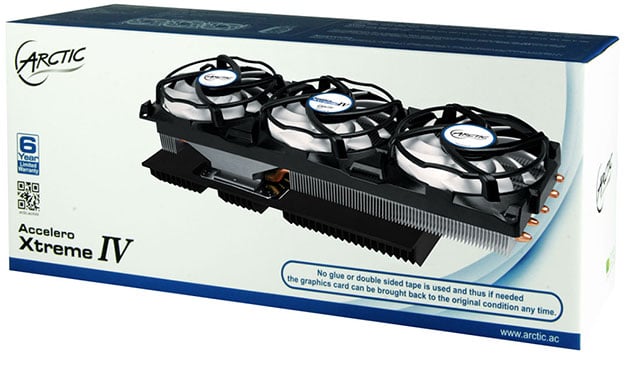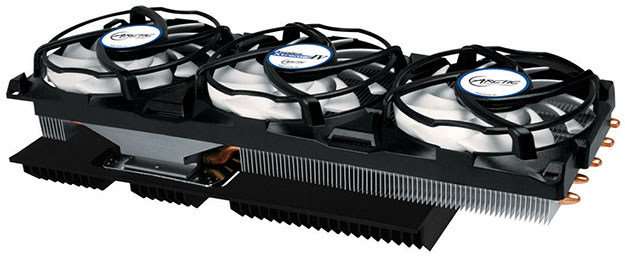Arctic Accelero Xtreme IV GPU Cooler Review: Chilling A GTX 1080 Ti Founders Edition
Arctic Accelero Xtreme IV: A Better GPU Cooler
It seems a little late in the game to be reviewing Arctic's Accelero Xtreme IV GPU cooler, so what gives? Well, I recently upgraded my ASUS ROG Strix GeForce GTX 1070 graphics card to an NVIDIA GeForce GTX 1080 Ti Founders Edition model, and while that is a solid GPU upgrade for sure, it is a downgrade acoustically and thermally.
Some people prefer the blower style cooler that ships on Founders Editions cards. I am not one of them. My main system sits in an open air Thermaltake Core P5 chassis, so there really is not a benefit to expelling hot hair out of the rear of the case, as Founders Edition cards do. If anything, the open air design exacerbates the noise since the card and cooler are not boxed in.
Noise was not the only factor in my decision to seek a relacement cooler. Temps played a role too. The custom cooler on my previous 1070 attacked thermals with three cooling fans and a series of heatpipes that make direct contact with the GPU (what ASUS calls DirectCU III technology). In contrast, the Founders Edition cooler sports a single fan, and it does not take long for temps to rise above 80C when stressing the GPU.
This lead me to go in search of a third-party GPU cooler, and surprisingly there are not a ton of options out there, especially if you narrow the field to air coolers. I decided to give the Accelero Xtreme IV a chance to impress, and for the most part, I am glad I did. I also thought I should write about it, as prices for Pascal cards are dropping fast with NVIDIA getting ready to launch a new generation of gaming cards. That means there should be even more deals on Pascal cards in the coming weeks and months.
Before I get to the nitty-gritty, here is a look at the specs...
|
| Max Cooling Capacity |
300 Watts |
| Aluminum Fins (Total) |
83 |
| Aluminum Fins (Thickness) |
0.3 mm |
| Heatpipes (Total) |
5 |
| Heatpipes (Thickness) |
6 mm |
| Fans | 3 x 92mm PWM |
| Fan Speed |
900 - 2,000 RPM |
| Noise Level |
0.4 Sone @ 2,000 RPM |
| Current / Voltage Per Fan |
0.12A / +12V DC |
| Power Consumption |
4.32 Watts |
| Dimensions With Backplate |
288 (L) x 77 (W) x 104 (H) mm / 11.34 x 3.03 x 4.09 inches |
| Weight |
991 g / 2.18 lbs) |
| Warranty |
6 Year Limited |
| Price | $89.99 MSRP ($57.07 On Amazon) |
The GeForce GTX 1080 Ti is a 250W card, so there is cooling capacity to spare on the Accelero Xtreme IV with its 300W rating. Just as importantly, the universal design is compatible with a wide range of cards. They include:
NVIDIA:
Titan Xp, Titan X (Pascal), GTX 1080(Ti), 1070 (Ti), 1060, Titan X, 980(Ti), 970, Titan (Black), 780 (Ti), 770, 760, 750 (Ti), 680, 670, 660 (Ti), 650 Ti (boost), 580, 570, 560 (Ti,SE), 550 Ti, 480, 460(SE), GTS 450, 250, 240 (OEM), GT 740, 9800 (GTX+, GTX, GT), 9600 (GT, GSO 512, GSO), 9500 GT (not LP), 8800 Ultra (G80), 8800 GTX (G80), 8800 GTS (G80), 8800 GTS 512 (G92), 8800 GTS (G92), 8800 GT, 8800 GS (9600GSO), 7900 GTX, 7800 (GTX 512, GTX, GT)
AMD:
RX 580, 570, 480, 470, R9 390(X), 380(X), 370X, 290(X), 285, 280(X), 270(X), R7 370, 265, HD 8870, 7970 (GHz), 7950 (Boost), 7870(XT, GHz), 7850, 6970, 6950, 6870, 6850, 6790, 5870, 5850, 5830, 4890, 4870, 4850, 4830, 3870, 3850
Notice that AMD's Radeon RX Vega cards are not listed. That is not an oversight, they really are not supported, unless you are willing to do some serious modding. Otherwise, you will have to look elsewhere.
For my purposes, the Accelero Xtreme IV fit the bill. It supports my card, is fairly inexpensive, and is a three-fan cooling solution like the one on my previous card. But is it easy to install? I'll get to that in a moment.
Unboxing The Accelero Xtreme IV
There are several pieces included with the Accelero Xtreme IV, all neatly organized and straightforward. Dumping out the contents reveals the main cooler itself, a brushed black aluminum backside heatsink, sticky thermal pads, protective film for the backside cooler, a 4-pin adapter cable, a metal T-bar (anchors the card with cooler to your expansion port), various hardware, and the documentation.
Now, on to the installation...









